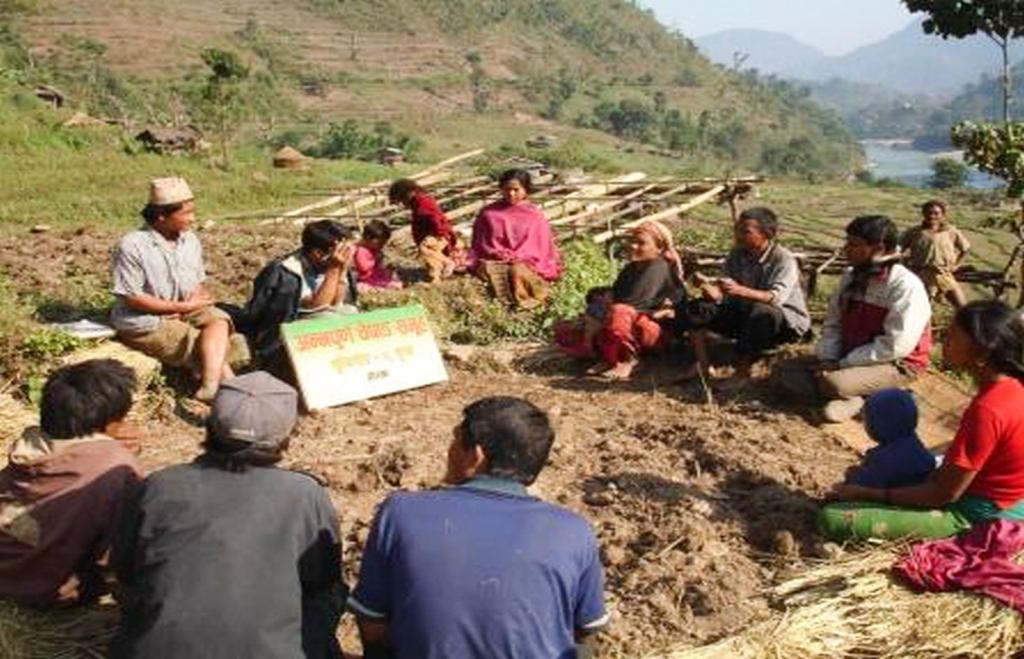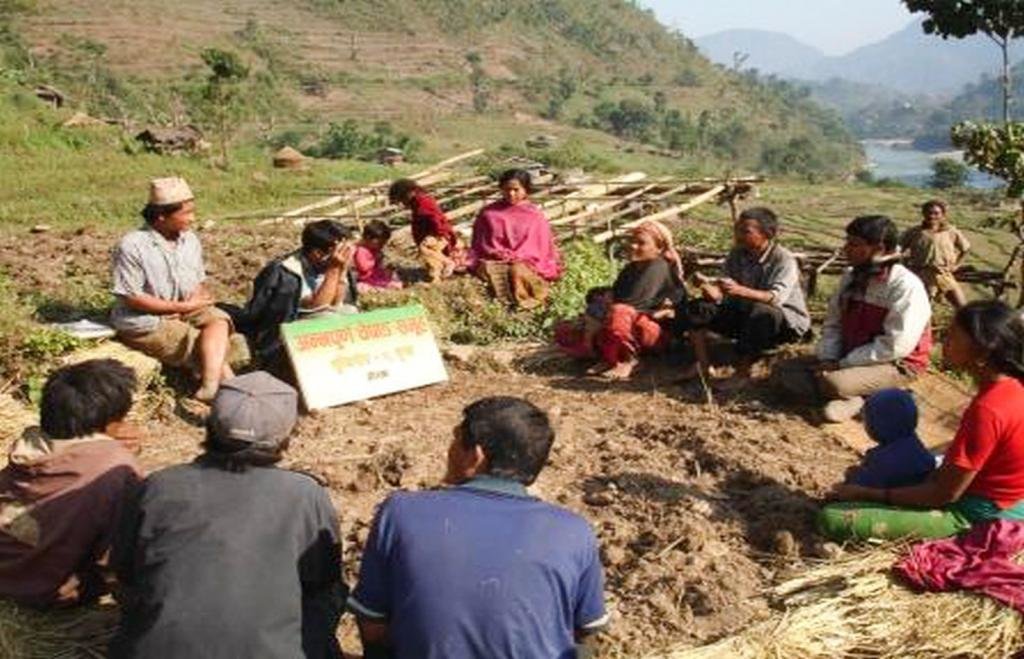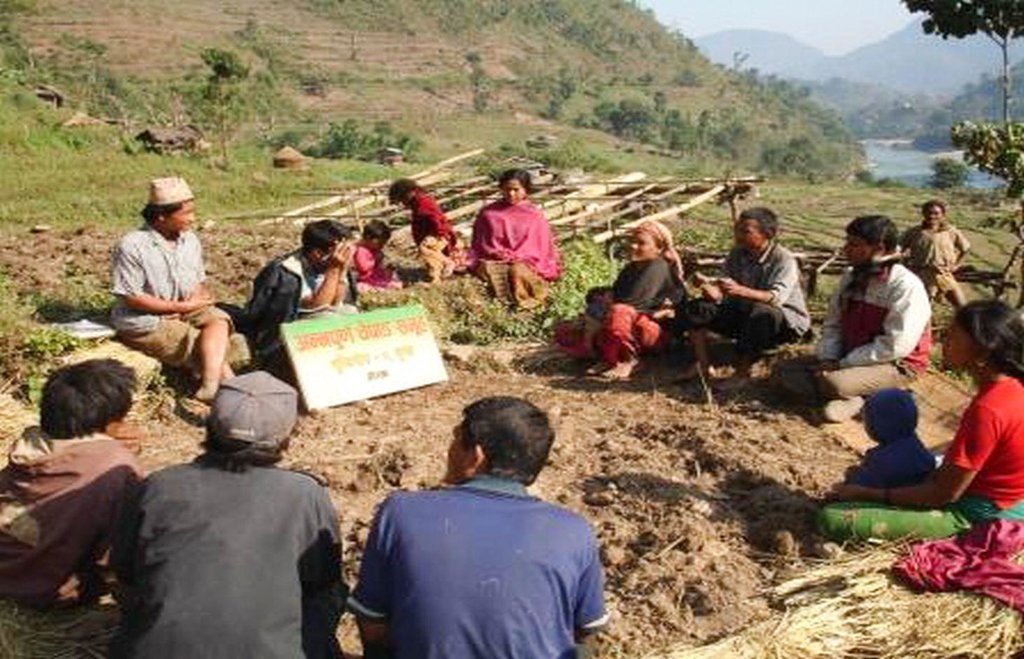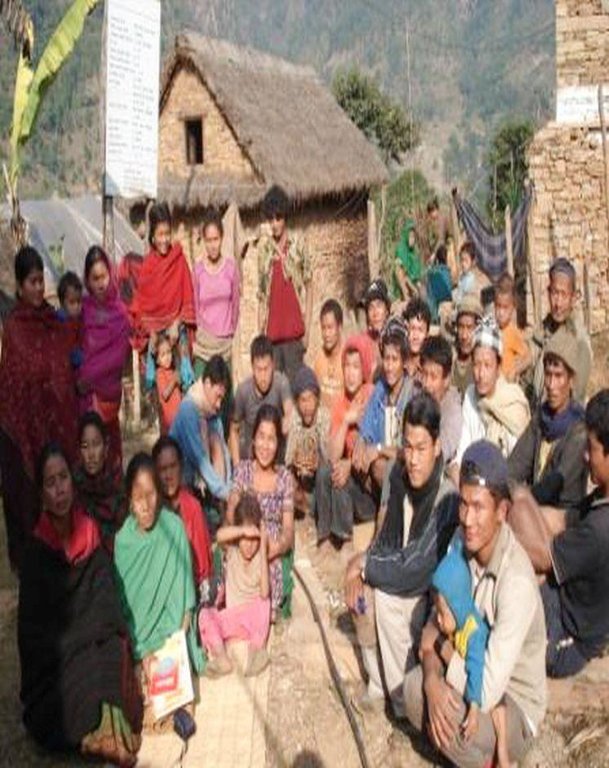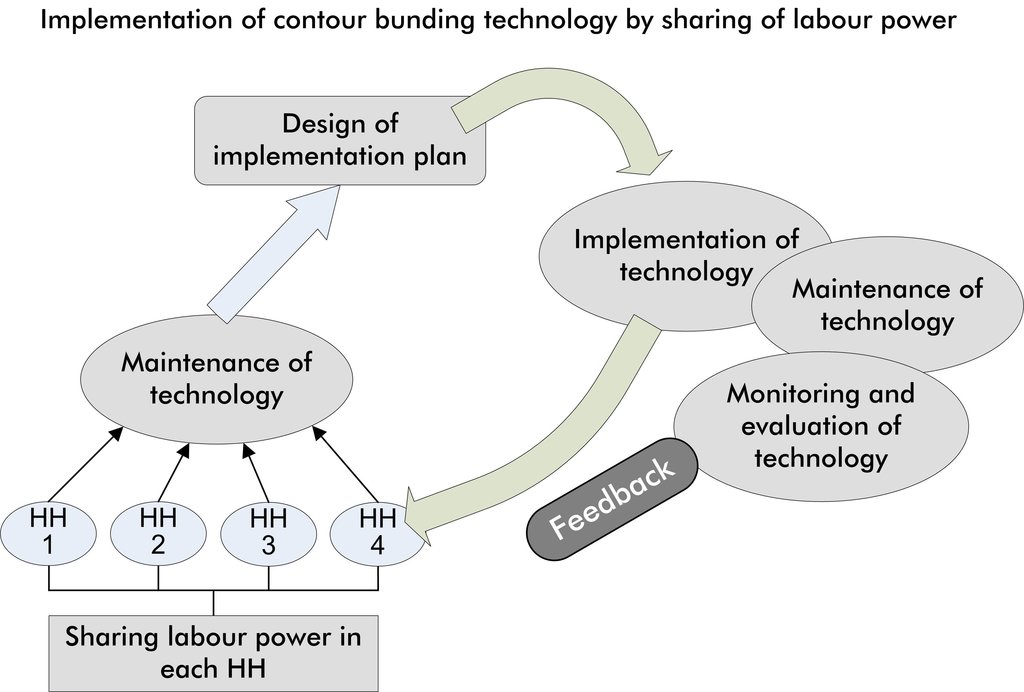Sharing labour to implement contour bunding [Nepal]
- Criação:
- Atualização:
- Compilador/a: Shreedip Sigdel
- Editor: –
- Revisor: Fabian Ottiger
Janasakti aadanpradhan gari bhajo halne padhiti karanwanan (Main contributor: Bir Bahadur Tamang, LI-BIRD)
approaches_2604 - Nepal
Veja as seções
Expandir tudo Recolher tudo1. Informação geral
1.2 Detalhes do contato das pessoas capacitadas e instituições envolvidas na avaliação e documentação da abordagem
Especialista em GST:
Tamanag Bir Bahadur
+977 61 526834 (0); 9746005992 (M)
btamang@libird.org
LI-BIRD, Gairapatan, Pokhara, P.O. Box 324
Nepal
Nome da(s) instituição(ões) que facilitou(ram) a documentação/avaliação da Abordagem (se relevante)
ICIMOD International Centre for Integrated Mountain Development (ICIMOD) - NepalNome da(s) instituição(ões) que facilitou(ram) a documentação/avaliação da Abordagem (se relevante)
Local Initiatives for Biodiversity, Research, and Development (LI-BIRD) - Nepal1.3 Condições em relação ao uso da informação documentada através de WOCAT
Quando os dados foram compilados (no campo)?
01/03/2013
O/a compilador/a e a(s) pessoa(s) capacitada(s) aceitam as condições relativas ao uso de dados documentados através da WOCAT:
Sim
2. Descrição da abordagem de GST
2.1 Descrição curta da abordagem
Members of a community can work together to help prevent soil erosion and increase productivity by working collectively to establish contour bunds.
2.2 Descrição detalhada da abordagem
Descrição detalhada da abordagem:
Aims / objectives: Over generations, the ethnic minorities of Nepal, who practice fireless shifting cultivation, known as 'gujultyaune', have successfully used contour bunding to control soil erosion, promote water retention, and increase crop production. Contour bunding is a proven sustainable land management practice in areas where the soil productivity of marginal, sloping, and hilly lands is very low. While it is both low cost and simple to implement, it does have the drawback that establishing contour bunds is very labour intensive. When members of a community work together to establish contour bunds the whole village can benefit.
Methods: By working collectively, a community can establish contour bunds that will benefit everyone and not individual farmers alone. The first step is to plan a course of action and to select the sites. Members of the community, who are thoroughly familiar with the landscape that the community inhabits, get together to discuss where the contour bunding will be most successful and benefit the greatest number of farmers. This planning phase is best carried out during the dry season before the rains begin. Once the sites are selected, everyone participates in the slashing of materials on the shifting cultivation lands. After the slashed materials have been allowed to dry for some weeks, the community assembles to gather these into rows that will form the bunds. Every member of the community participates according to their ability.
Stages of implementation: The steps for sharing labour to establish contour bunds in a community which practises shifting cultivation can be summarized as follows:
• The community meets to finalize a plan of action.
• Everyone participates in the slashing of shifting cultivation plots.
• The slashed materials are collected and allowed to dry.
• The slashed materials are formed into rows that will constitute the bunds.
• Everyone participates and eventually, the land between the bunds is prepared for the cultivation of crops.
2.3 Fotos da abordagem
2.5 País/região/locais onde a abordagem foi aplicada
País:
Nepal
Especificação adicional de localização:
Tanahun, Gorkha District
2.7 Tipo de abordagem
- Tradicional/Indígena
2.8 Principais metas/objetivos da abordagem
The Approach focused mainly on SLM with other activities (increasing crop production)
To increase crop yields and help to prevent soil erosion in communities that practise shifting cultivation by getting the whole community to participate in establishing contour bunds.
The SLM Approach addressed the following problems: The main stumbling blocks to this approach are a gap in the sharing of traditional knowledge, lack of the money needed for investment, community conflicts over allocation of resources, and overall poor social cohesiveness.
2.9 Condição que propiciam ou inibem a implementação de tecnologia/tecnologias aplicada(s) segundo a abordagem
Disponibilidade/acesso a recursos e serviços financeiros
- Inibitivo
Individual farmers do not have sufficient resources to
implement the technology on their own
Treatment through the SLM Approach: By sharing labour everyone benefits without any outlay by individual farmers
Quadro institucional
- Inibitivo
Groups are not aware of how to mobilize for community empowerment
Treatment through the SLM Approach: Raise level of awareness and enhance capacity on how to mobilize the community and on how to institutionalize the process
Conhecimento sobre GST, acesso a suporte técnico
- Inibitivo
Traditional knowledge on contour bunding is not shared
Treatment through the SLM Approach: Technical information is shared when the technology is implemented
3. Participação e papel das partes interessadas envolvidas
3.1 Partes interessadas envolvidas na abordagem e seus papéis
- Usuários de terra/comunidades locais
This technology is straightforward; the community of land users can implement it without external input. This is a sustainable land management practice in areas where shifting cultivation is practised. These areas have typically been inhabited by poor and marginal groups like the Chepang, Magar, Dalit, and Gurung groups.
3.2 Envolvimento do usuários de terra/comunidades locais nas diferentes fases da abordagem
| Envolvimento do usuários de terra/comunidades locais | Especifique quem estava envolvido e descreva as atividades | |
|---|---|---|
| Iniciação/motivação | Automobilização | Demand created by the community |
| Planejamento | Participativo | Through discussions the whole community is involved in deciding what sites are to be contoured and how the bunding technology is to be implemented. |
| Implementação | Automobilização | The whole community is involved in planning the sites, slashing the biomass, and forming the contour bunds. |
| Monitoramento/avaliação | Nenhum | |
| Research | Nenhum |
3.3 Fluxograma (se disponível)
Descrição:
Each household (HH) contributes labour and the community works together to implement contour bunding.
Autor:
AK Thaku
3.4 Decisão sobre a seleção de tecnologia/tecnologias de GST
Especifique quem decidiu sobre a seleção de tecnologia/tecnologias a serem implementadas:
- Somente usuários da terra (iniciativa própria)
Explique:
The land users themselves decide on the technology during participatory discussions held in the community. This is a bottom-up approach
Decisions on the method of implementing the SLM Technology were made by by land users* alone (self-initiative / bottom-up). The land users themselves possess traditional knowledge on how the technology should be implemented. Since some farmers have a better grasp of the technology than others, the different methods are discussed and the community as a whole decides what method is to be used.
4. Suporte técnico, reforço das capacidades e gestão do conhecimento
4.1 Reforço das capacidades/ formação
Foi oferecida formação aos usuários da terra/outras partes interessadas?
Sim
Especifique quem foi capacitado:
- Usuários de terra
Tipo de formação:
- Agricultor para agricultor
- Áreas de demonstração
- Reuniões públicas
4.2 Serviço de consultoria
Os usuários de terra têm acesso a um serviço de consultoria?
Sim
4.3 Fortalecimento da instituição (desenvolvimento organizacional)
As instituições foram fortalecidas ou estabelecidas através da abordagem?
- Não
4.4 Monitoramento e avaliação
Monitoramento e avaliação são partes da abordagem?
Sim
Comentários:
bio-physical aspects were regular monitored by land users through measurements; indicators: Land users regularly monitor the organic matter and moisture content of the soil and establish plants in bunds
technical aspects were regular monitored by land users through measurements; indicators: Land users regularly monitor terrace formation and soil erosion
socio-cultural aspects were regular monitored by land users through observations; indicators: The community observes and comments on the degree to which contour bunding is implemented
economic / production aspects were regular monitored by land users through measurements; indicators: Land users note crop production and how it affects their cash income
area treated aspects were regular monitored by land users through measurements; indicators: Land users regularly monitor small patches used in shifting cultivation
no. of land users involved aspects were regular monitored by land users through observations; indicators: The whole community participates in observing how many people are involved
management of Approach aspects were regular monitored by land users through measurements; indicators: The whole community participates
There were few changes in the Approach as a result of monitoring and evaluation: Gradually, farmers in other communities are also adopting the same approach
5. Financiamento e apoio material externo
5.1 Orçamento anual para o componente de GST da abordagem
Caso o orçamento exato seja desconhecido, indique a faixa:
- < 2.000
Comentários (p. ex. principais fontes de recursos/principais doadores):
Approach costs were met by the following donors: national non-government (LI-BIRD): 20.0%; local community / land user(s): 80.0%
5.2 Apoio financeiro/material concedido aos usuários da terra
Os usuários da terra receberam apoio financeiro/material para a implementação de tecnologia/tecnologias?
Não
5.4 Crédito
Foi concedido crédito segundo a abordagem para atividades de GST?
Não
6. Análise de impactos e declarações finais
6.1 Impactos da abordagem
A abordagem auxiliou os usuários da terra a implementar e manter as tecnologias de GST?
- Não
- Sim, pouco
- Sim, moderadamente
- Sim, significativamente
The approach was a good way of improving sloping land management.
A abordagem concedeu autonomia aos grupos social e economicamente desfavorecidos?
- Não
- Sim, pouco
- Sim, moderadamente
- Sim, significativamente
Moderate improvements were noted in Chepang, Magar, and Dalit households who benefited from this approach and improved their livelihoods
Did other land users / projects adopt the Approach?
- Não
- Sim, pouco
- Sim, moderadamente
- Sim, significativamente
Those who implemented this approach cited improved soil fertility and the increased productivity of cash crops like legumes as a plus point.
Did the Approach lead to improved livelihoods / human well-being?
- Não
- Sim, pouco
- Sim, moderadamente
- Sim, significativamente
these were mainly due to the increased earnings from the production of cash crops. Earnings were invested on daily needs which improved livelihoods.
Did the Approach help to alleviate poverty?
- Não
- Sim, pouco
- Sim, moderadamente
- Sim, significativamente
Some poverty alleviation was noted among households who could increase the amount that they earned from cash crops. These households used the additional earnings on health care and education.
6.2 Principal motivação dos usuários da terra para implementar a GST
6.3 Atividades de sustentabilidade de abordagem
Os usuários da terra podem manter o que foi implementado através da abordagem (sem apoio externo)?
- Sim
Caso afirmativo, descreva como:
This is a community-based approach; each community formulates its own rules and regulations.
6.4 Pontos fortes/vantagens da abordagem
| Pontos fortes/vantagens/oportunidades na visão do/a compilador/a ou de outra pessoa capacitada |
|---|
| Effectiveness (How to sustain/ enhance this strength: Improve the approach by continuing to work together to design, plan, and implement.) |
| Increases social cohesiveness (How to sustain/ enhance this strength: Continue to work collaboratively) |
| Decreased workload (How to sustain/ enhance this strength: Over time, the group decisions that work best no longer need to be revisited and less time is spent in discussions.) |
| Quick implementation of sloping land management measures (How to sustain/ enhance this strength: As the group learns to work together they can taking advantage of their synergy to quickly implement new measures.) |
| Empowerment (How to sustain/ enhance this strength: Encourage the community with technical backstopping) |
6.5 Pontos fracos, desvantagens da tecnologia e formas de superá-los
| Pontos fracos/vantagens/riscos na visão do/a compilador/a ou de outra pessoa capacitada | Como eles podem ser superados? |
|---|---|
| Some members contribute more than others | Each member of the group needs to be made aware of how they can contribute. |
7. Referências e links
7.1 Métodos/fontes de informação
- visitas de campo, pesquisas de campo
- entrevistas com usuários de terras
7.2 Referências às publicações disponíveis
Título, autor, ano, ISBN:
Indigenous knowledge of farmers in the shifting cultivation areas of Western Nepal, Regmi, BR; Aryal, KP; Subedi, A; Shrestha, PK; Tamang, BB (2001)
Links e módulos
Expandir tudo Recolher tudoLinks
Não há links
Módulos
Não há módulos


